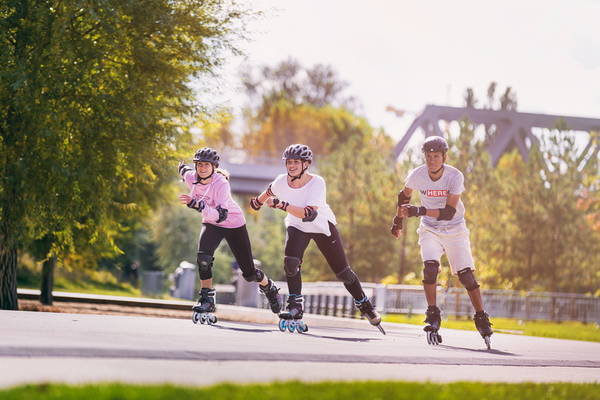Inline Skating - Fundamental Skills

Effective inline skating requires mastering a stable position on the skates, learning how to halt, turning agilely, and understanding how to fall safely. This guide will equip you with all the necessary skills for inline skating as a novice.
Inline skating is truly universal – it suits everyone, regardless of age or size. A pair of inline skates, some protective equipment, and a smooth, traffic-free surface are the essentials to embark on your practice journey. Initially, the learning curve might seem daunting, but with just a few hours of perseverance, you'll start seeing improvements, so keep at it!
Position on Inline Skates
To maintain the correct stance on your inline skates, you should keep your knees bent. This lowers your centre of gravity, enhancing your balance.
Feet should remain parallel and directed straight ahead, avoiding any inward or outward angles.
With knees bent, feet parallel, and a slight forward lean of the upper body, you will achieve a stance that is both balanced and stabilised.
Watch our instructional video, How to Skate on Inline Skates:
Stopping Techniques on Inline Skates
To halt while inline skating, you can opt for either the brake pad method or the T-stop technique. Both are detailed in our video guide, How to Stop on Inline Skates:
Applying the Brake Pad on Inline Skates
To use the brake pad, push the skate with the pad forward and raise your toes so that the pad makes contact with the ground, thus reducing your speed. The brake pad allows you to adjust your rolling speed easily or bring yourself to a complete halt. As a beginner, familiarising yourself with the brake pad is advisable for maintaining control.
T-Stop Technique with Inline Skates
The T-stop method involves positioning one foot behind and dragging the wheels across the ground at a right angle to the other foot, creating a T shape. Continue dragging the wheels until a stop is achieved. Mastering a T-stop requires balancing on a single foot while in motion.
Performing a T-stop on inline skates offers the ability to slow down using your wheels without relying on a brake pad. This ability provides a significant advantage since brake pads can sometimes obstruct. For newcomers, learning the T-stop is beneficial as it helps in gaining better control over your movements on inline skates.
Turning on Inline Skates
When executing a turn on inline skates, maintain a light forward lean with your knees bent. To turn left, move your left foot slightly forward, and conversely to turn right. Shift your weight toward the direction of the turn, while leaning into it with your upper body. Visualising in the direction of your turn can greatly assist.
Focusing on the turning technique helps in avoiding typical beginner errors and facilitates learning the cross-over technique as you advance.
Safe Falling Techniques for Inline Skating
Falling forward is preferable as it allows for control, preventing impact to the back of the head or tailbone.
If you're losing balance on inline skates, take these steps:
- Crouch and lean forward – staying low reduces the impact of a fall, and might even help you recover balance.
- Utilise protective gear for impact – falling on your knee pads, elbow pads, or wrist pads means they absorb the shock instead of you. When moving swiftly, slide on your protectors to prevent scrapes.
By employing these methods, you're less likely to incur injuries that could hinder your inline skating journey.
Selecting the Ideal Inline Skates for Beginners
Both new and seasoned inline skaters should prioritise obtaining skates that fit snugly and offer comfort. For newcomers, skates with a heel brake and solid ankle support are key. Opt for softer wheels (76A - 84 A) and ensure the wheels are of a manageable size – no larger than 84 mm for adults with larger feet, while for children, sizes below 70 mm are optimal.
Refer to our buying guides for further insights on purchasing inline skates:
